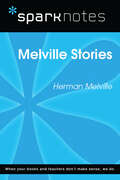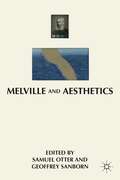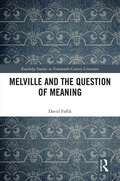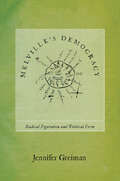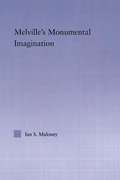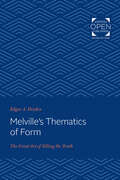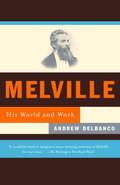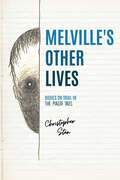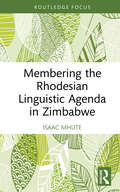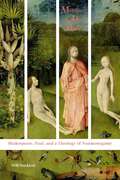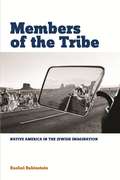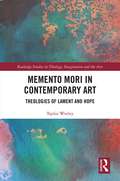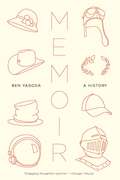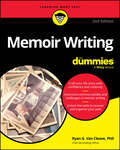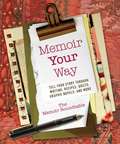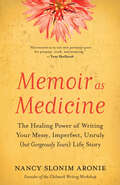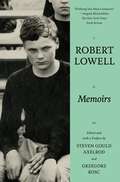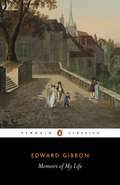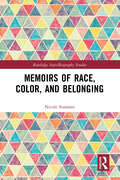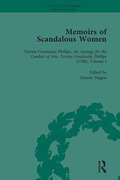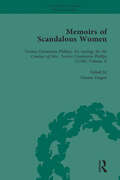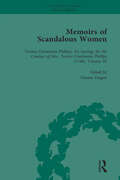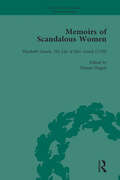- Table View
- List View
Melville Stories (SparkNotes Literature Guide Series)
by SparkNotesMelville Stories (SparkNotes Literature Guide) by Herman Melville Making the reading experience fun! Created by Harvard students for students everywhere, SparkNotes is a new breed of study guide: smarter, better, faster. Geared to what today's students need to know, SparkNotes provides: *Chapter-by-chapter analysis *Explanations of key themes, motifs, and symbols *A review quiz and essay topicsLively and accessible, these guides are perfect for late-night studying and writing papers
Melville and Aesthetics
by Geoffrey Sanborn Samuel OtterIn an original and provocative series of readings that range across Melville's career, the contributors consider not only the sources and implications of Melville's aesthetics, but the relationship between aesthetic criticism, historical analysis, and contemporary theory.
Melville and the Idea of Blackness: Race and Imperialism in Nineteenth Century America
by Christopher FreeburgBy examining the unique problems that 'blackness' signifies in Moby-Dick, Pierre, 'Benito Cereno' and 'The Encantadas', Christopher Freeburg analyzes how Herman Melville grapples with the social realities of racial difference in nineteenth-century America. Where Melville's critics typically read blackness as either a metaphor for the haunting power of slavery or an allegory of moral evil, Freeburg asserts that blackness functions as the site where Melville correlates the sociopolitical challenges of transatlantic slavery and U.S. colonial expansion with philosophical concerns about mastery. By focusing on Melville's iconic interracial encounters, Freeburg reveals the important role blackness plays in Melville's portrayal of characters' arduous attempts to seize their own destiny, amass scientific knowledge and perfect themselves. A valuable resource for scholars and graduate students in American literature, this text will also appeal to those working in American, African American and postcolonial studies.
Melville and the Question of Meaning (Routledge Studies in Nineteenth Century Literature)
by David FaflikThis rich volume of essays restores meaning itself as the focal point of one of our most thoughtful modern writers, Herman Melville. Melville and the Question of Meaning thinks about thinking in Melville. For if Melville’s concerns with interpretation (the contributors to one recent collection variously read the author for "the ‘meaning’ of the characters," the "meaning" of the "body," "recesses of meaning," "deepest levels of meaning," "double meaning," and the "meaning" of "being" and "everything else") overlap with our own concerns, at a cultural moment when meaning feels especially strained, we have lost sight of the central place of meaning making in Melville’s work. My own readings in Melville are a pedestrian’s guide through the self-conscious complications of meaning we meet with in Melville across a range of different disciplines and endeavors. Combining aesthetics and sociolinguistics, history and theory, rhetoric and politics, philosophy and film studies, Melville and the Question of Meaning demonstrates that the project of making meaning in Melville remains as vital as ever.
Melville's Democracy: Radical Figuration and Political Form
by Jennifer GreimanFor Herman Melville, the instability of democracy held tremendous creative potential. Examining the centrality of political thought to Melville's oeuvre, Jennifer Greiman argues that Melville's densely figurative aesthetics give form to a radical reimagining of democratic foundations, relations, and ways of being—modeling how we can think democracy in political theory today. Across Melville's five decades of writing, from his early Pacific novels to his late poetry, Greiman identifies a literary formalism that is radically political and carries the project of democratic theory in new directions. Recovering Melville's readings in political philosophy and aesthetics, Greiman shows how he engaged with key problems in political theory—the paradox of foundations, the vicious circles of sovereign power, the fragility of the people—to produce a body of radical democratic art and thought. Scenes of green and growing life, circular structures, and images of a groundless world emerge as forms for understanding democracy as a collective project in flux. In Melville's experimental aesthetics, Greiman finds a significant precursor to the tradition of radical democratic theory in the US and France that emphasizes transience and creativity over the foundations and forms prized by liberalism. Such politics, she argues, are necessarily aesthetic: attuned to material and sensible distinctions, open to new forces of creativity.
Melville's Monumental Imagination (Studies in Major Literary Authors)
by Ian S. MaloneyMelville's Monumental Imagination explores the connection between the contested 19th century American monument tradition and one of the nation's most revered authors, Herman Melville (1819-1891). The book was written to fill a void in recent Melville scholarship. To date, there has not been a monograph that focuses exclusively on Melville's incorporation of monuments in his fictional world. The book charts the territory of Melville's novels in order to provide a trajectory of the monumental image in one particular literary form. This feature allows the reader to gradually see the monumental image as an important marker that sheds light into Melville's eventual abandonment of long fiction. Melville's Monumental Imagination combines literary analysis and cultural criticism for a long neglected aspect of our nation's iconic development in statuary.
Melville's Thematics of Form: The Great Art of Telling the Truth
by Edgar DrydenOriginally published in 1968. Professor Dryden sees Melville's novels both as metaphysical processes and as technical forms. The novelist is not a reporter but a creator, and what he creates from his experience is his vision of truth. Herman Melville saw the function of the novelist in terms of his ability to expose the reader to truth while simultaneously protecting him from it or, in other words, to enable the reader to experience reality indirectly and, therefore, safely. In Melville's own writing, however, this function became more difficult as his nihilism deepened. He became increasingly sensitive to his own involvement in the world of lies, and when he could no longer protect himself from the truth, he could no longer transform it into fiction. Melville's struggle to maintain the distinction between art and truth was reflected in the changing forms of his novels.Dryden traces Melville's evolving metaphysical views and studies their impact on the craftsmanship of this acutely self-conscious artist from his early novels—Typee, Redburn, and White Jacket—through Moby-Dick, Pierre, Israel Potter, and The Confidence-Man to the posthumously published Billy Budd and the closely related Benito Cereno, and he concludes that "all of Melville's narrators are in some way portraits of the artist at work." Dryden's study is a unique contribution to Melville scholarship and an important journey through the world of the novelist's vision. As such, it has significant implications for the novel as a genre and for understanding its development in America.
Melville: His World and Work
by Andrew DelbancoIf Dickens was nineteenth-century London personified, Herman Melville was the quintessential American. With a historian's perspective and a critic's insight, award-winning author Andrew Delbanco marvelously demonstrates that Melville was very much a man of his era and that he recorded -- in his books, letters, and marginalia; and in conversations with friends like Nathaniel Hawthorne and with his literary cronies in Manhattan -- an incomparable chapter of American history. From the bawdy storytelling of Typee to the spiritual preoccupations building up to and beyond Moby Dick, Delbanco brilliantly illuminates Melville's life and work, and his crucial role as a man of American letters.
Melville’s Other Lives: Bodies on Trial in The Piazza Tales (Peculiar Bodies)
by Christopher StenMelville’s Other Lives is the first book-length study on The Piazza Tales—Herman Melville’s only authorized collection of short fiction published in his lifetime—and the first book to explore the rich and varied subject of embodiment in any published collection of Melville’s stories.As Christopher Sten shows, all of the stories in The Piazza Tales present encounters between established white male figures: a writer, a lawyer, a ship captain, a homeowner, an architect, a world traveler, and characters who are outsiders, minorities, outcasts, or "others": a seamstress, an office drudge, enslaved Africans, a traveling salesman, island castaways, the poor. In each, Melville concentrates on the trials of the human body, its pain and trauma, its struggles and frustrations. Some tales concern common trials such as illness or invalidism ("The Piazza"), the tedium of office work ("Bartleby"), or the aggravation of door-to-door salesmen ("The Lightning-Rod Man"). Others concern extraordinary trials: the traumatic violence of a rebellion on a slave ship ("Benito Cereno"), the hardships of surviving on a wasteland archipelago ("The Encantadas"), the perils of creating a monstrous "man-machine" ("The Bell-Tower"). In their concern for the cultural meanings of such trials, Melville’s stories look forward to the work of Michel Foucault, Raymond Williams, and other cultural materialists who have shown how cultures define, control, and oppress bodies based on their otherness. As a storyteller, Melville understood how such cultural dynamics operate and seized on our collective obsession with the human body as subject, symbol, and vehicle to dramatize his tales.
Membering the Rhodesian Linguistic Agenda in Zimbabwe
by Isaac MhuteMembering the Rhodesian Linguistic Agenda in Zimbabwe reports on a study carried out in Zimbabwe to ascertain the degree and effect of honouring the colonial linguistic agenda. The book employs an interpretivist philosophy and qualitative research approach that relies on participatory observations, interviewing purposively sampled informants and focus group discussions involving snowball sampled graduates. It was inspired by the Critical Language Policy Theory that considers language choice a critical determinant factor in how communities are administered politically, economically, socioculturally and educationally. It establishes that whereas linguistic imperialism meant to serve as the lifeblood of the Southern Rhodesian colonial machine, the former coloniser ensured coloniality in Zimbabwe by presenting the English language as a sacred media in political, economic, sociocultural and educational settings forever. The study establishes that the only way Zimbabwe and other such post-colonies could find redemption is by eradicating the sacredness of former colonisers’ languages by adding value to all their languages and the indigenous knowledge systems associated with them. It also demonstrates that the bigger the delay, the more is irretrievably lost together with custodians of the languages. This book will be informative for undergraduates, postgraduates and researchers in linguistics, communication, sociology, anthropology and history. It may also serve well as a resource to government researchers, politicians and other policymakers.
Members of His Body: Shakespeare, Paul, and a Theology of Nonmonogamy
by Will StocktonBuilding on scholarship regarding both biblical and early modern sexualities, Members of His Body protests the Christian defense of marital monogamy. According to the Paul who authors 1 Corinthians, believers would do well to remain single and focus instead on the messiah’s return. According to the Paul who authors Ephesians, plural marriage is the telos of Christian community. Turning to Shakespeare, Will Stockton shows how marriage functions in The Comedy of Errors, The Merchant of Venice, Othello, and The Winter’s Tale as a contested vehicle of Christian embodiment. Juxtaposing the marital theologies of the different Pauls and their later interpreters, Stockton reveals how these plays explore the racial, religious, and gender criteria for marital membership in the body of Christ. These plays further suggest that marital jealousy and paranoia about adultery result in part from a Christian theology of shared embodiment: the communion of believers in Christ.In the wake of recent arguments that expanding marriage rights to gay people will open the door to the cultural acceptance and legalization of plural marriage, Members of His Body reminds us that much Christian theology already looks forward to this end.
Members of the Tribe: Native America in the Jewish Imagination
by Rachel RubinsteinIn Members of the Tribe: Native America in the Jewish Imagination, author Rachel Rubinstein examines interventions by Jewish writers into an ongoing American fascination with the "imaginary Indian." Rubinstein argues that Jewish writers represented and identified with the figure of the American Indian differently than their white counterparts, as they found in this figure a mirror for their own anxieties about tribal and national belonging. Through a series of literary readings, Rubinstein traces a shifting and unstable dynamic of imagined Indian-Jewish kinship that can easily give way to opposition and, especially in the contemporary moment, competition. In the first chapter, "Playing Indian, Becoming American," Rubinstein explores the Jewish representations of Indians over the nineteenth century, through narratives of encounter and acts of theatricalization. In chapter 2, "Going Native, Becoming Modern," she examines literary modernism's fascination with the Indian-poet and a series of Yiddish translations of Indian chants that appeared in the modernist journal Shriftn in the 1920s. In the third chapter, "Red Jews," Rubinstein considers the work of Jewish writers from the left, including Tillie Olsen, Michael Gold, Nathanael West, John Sanford, and Howard Fast, and in chapter 4, "Henry Roth, Native Son," Rubinstein focuses on Henry Roth's complicated appeals to Indianness. The final chapter, "First Nations," addresses contemporary contestations between Jews and Indians over cultural and territorial sovereignty, in literary and political discourse as well as in museum spaces. As Rubinstein considers how Jews used the figure of the Indian to feel "at home" in the United States, she enriches ongoing discussions about the ways that Jews negotiated their identity in relation to other cultural groups. Students of Jewish studies and literature will enjoy the unique insights in Members of the Tribe.
Memento Mori in Contemporary Art: Theologies of Lament and Hope (Routledge Studies in Theology, Imagination and the Arts)
by Taylor WorleyThis book explores how four contemporary artists—Francis Bacon, Joseph Beuys, Robert Gober, and Damien Hirst—pursue the question of death through their fraught appropriations of Christian imagery. Each artist is shown to not only pose provocative theological questions, but also to question the abilities of theological speech to adequately address current attitudes to death. When set within a broader theological context around the thought of death, Bacon’s works invite fresh readings of the New Testament’s narration of the betrayal of Christ, and Beuys’ works can be appreciated for the ways they evoke Resurrection to envision possible futures for Germany in the aftermath of war. Gober’s immaculate sculptures and installations serve to create alternative religious environments, and these places are both evocative of his Roman Catholic upbringing and virtually haunted by the ghosts of his excommunication from that past. Lastly and perhaps most problematically, Hirst has built his brand as an artist from making jokes about death. By opening fresh arenas of dialogue and meaning-making in our society and culture today, the rich humanity of these artworks promises both renewed depths of meaning regarding our exit from this world as well as how we might live well within it for the time that we have. As such, it will be a vital resource for all scholars in Theology, the Visual Arts, Material Religion and Religious Studies.
Memoir
by Ben YagodaFrom a critically acclaimed cultural and literary critic, a definitive history and analysis of the memoir. From Saint Augustine?s Confessions to Augusten Burroughs?s Running with Scissors, from Julius Caesar to Ulysses Grant, from Mark Twain to David Sedaris, the art of memoir has had a fascinating life, and deserves its own biography. Cultural and literary critic Ben Yagoda traces the memoir from its birth in early Christian writings and Roman generals? journals all the way up to the banner year of 2007, which saw memoirs from and about dogs, rock stars, bad dads, good dads, alternadads, waitresses, George Foreman, Iranian women, and a slew of other illustrious persons (and animals). In a time when memoir seems ubiquitous and is still highly controversial, Yagoda tackles the autobiography and memoir in all its forms and iterations. He discusses the fraudulent memoir and provides many examples from the past?and addresses the ramifications and consequences of these books. Spanning decades and nations, styles and subjects, he analyzes the hallmark memoirs of the Western tradition?Rousseau, Ben Franklin, Henry Adams, Gertrude Stein, Edward Gibbon, among others. Yagoda also describes historical trends, such as Native American captive memoirs, slave narratives, courtier dramas (where one had to pay to NOT be included in a courtesan?s memoir). Throughout, the idea of memory and truth, how we remember and how well we remember lives, is intimately explored. Yagoda?s elegant examination of memoir is at once a history of literature and taste, and an absorbing glimpse into what humans find interesting?one another. .
Memoir Writing For Dummies
by Ryan G. Van CleaveUnlock your storytelling journey with expert guidance Memoir writing isn’t just for celebrities and politicians. For anyone prone to self-reflection and ready to give shape to your memories and experiences, Memoir Writing For Dummies is your definitive guide. This book offers a concrete roadmap for writing a captivating memoir. Get advice on exploring your past, mapping out your story, and perfecting your plot, setting, character, and dialogue. You’ll also find information on recruiting the help of AI and digital media for a more dynamic storytelling experience. Whether you’re an amateur author with a story to tell or a bestselling author trying out a new genre, Memoir Writing For Dummies will guide you every step of the way. Gain a deep understanding of the memoir genre and kickstart your journey into autobiographical writing Learn how to structure your memoir to grab readers’ attention from the first page and keep them engrossed throughout Organize your thoughts, address sensitive topics, and seamlessly weave your insights and reactions into your narrative Embrace technology to streamline your writing process and share your story with the world Everyone has a story worth sharing, and Memoir Writing For Dummies provides would-be memoirists with the essential tools they need to share their life stories with the world and become published authors.
Memoir Writing For Dummies
by Ryan Van CleaveLearn to:Mine your past for great storiesChoose the best structure to highlight your storyGet your memoir publishedMarket your finished memoirExpert tips and strategies to help you craft your life story and get it published!Memoir writing is a growing phenomenon - and it's not just for celebrities and politicians. Everyone has a story to tell, and Memoir Writing For Dummies provides you with the tools you need to share your life story with the world. With easy-to-follow, step-by-step instructions - along with helpful tips and advice on how to get published - Memoir Writing For Dummies shows you how to put pen to paper and hone the craft of writing a truly compelling memoir. You'll get advice on how to explore your memories, map out your story, perfect your plot, and so much more. Packed with proven tips and writing tricks of the trade, Memoir Writing For Dummies gives you everything you need to ensure your life story is never forgotten.Remember the past - put on your research cap and uncover your memoriesGet over writer's block - find out how to deal with distractions and focus on the taskWrite your first draft - develop your structure, setting, characters, and dialogueEdit your work - explore ways to push your story to the next level and make revisions like the prosGet published - understand the publishing process and decide which route is right for youMarket your memoir - develop strategies to get the word out about your memoirOpen the book and find:Ways to unlock your memoriesWriting exercises in each chapter to improve your manuscriptHow to use metaphor and figurative languageStrategies for fine-tuning your storyTips for editing your workHow to find a literary agentUnderstanding the difference between traditional publishing and self-publishingWays to promote your finished product
Memoir Your Way: Tell Your Story through Writing, Recipes, Quilts, Graphic Novels, and More
by The Memoir RoundtableA new approach to family and personal memoirs that includes many creative formats.Memoir Your Way inspires family storykeepers to create a memoir using a craft you already know or are inspired to learn to create a personal, polished memoir your family will treasure. Accessible and with broad appeal, this first-of-its-kind book extends the written memoir form to cookbooks, scrapbooks, quilts, and other forms of storytelling.Readers of Memoir Your Way will find out how to:Create your own family cookbook like a proDesign, stitch, and create stunning quilts that preserve family memories for the next generation and create a cherished giftBring out the natural storyteller in children while building self-confidence and a sense of familyWrite engaging family stories with proven writing tipsEnrich scrapbooks with stories that might otherwise be overlooked and techniques that showcase even the memories that weren't preserved in photographsTurn your story into a graphic novel with hand-drawn illustrationsBecome the bridge for your heritage between the old world and the newMemoir Your Way makes memoir accessible to everyone, including those who don't see themselves as writers. Memoir Your Way is a valuable sourcebook for quickly and easily creating memoirs that celebrate family stories and ancestry.
Memoir as Medicine: The Healing Power of Writing Your Messy, Imperfect, Unruly (but Gorgeously Yours) Life Story
by Nancy Slonim AronieA wonderfully fresh and frank guide to why and how to write personal stories that will heal, liberate, inspire — and entertain — both writer and reader Writing has been medicine for Nancy Slonim Aronie. At nine months old, her son Dan was diagnosed with diabetes. Then, at twenty-two, he was diagnosed with multiple sclerosis. During the years she and her husband took care of Dan, and when he died at age thirty-eight, Aronie could not find the book she needed. So she wrote her memoir. In teaching memoir writing, Aronie has found that everyone has a story to tell and that telling it is important. Sharing “this is who I am, these are the things that shaped me, this is where I am now” allows a kind of magic and healing to happen. Over decades of writing and teaching, Aronie has created a set of prompts, directions, and examples that she shares in Memoir as Medicine. She shows readers how to write through where they have been and into deep understanding, profound healing, and even unexpected joy.
Memoirs
by Robert LowellA complete collection of Robert Lowell’s autobiographical prose, from unpublished writings about his youth to reflections on the triumphs and confusions of his adult life.Robert Lowell's Memoirs is an unprecedented literary discovery: the manuscript of Lowell’s lyrical evocation of his childhood, which was written in the 1950s and has remained unpublished until now. Meticulously edited by Steven Gould Axelrod and Grzegorz Kosc, it serves as a precursor or companion to his groundbreaking book of poems Life Studies, which signaled a radically new prose-inflected direction in his work, and indeed in American poetry. Memoirs also includes intense depictions of Lowell’s mental illness and his determined efforts to recover. It concludes with Lowell’s reminiscences of other writers, among them T. S. Eliot, Robert Frost, Ezra Pound, John Berryman, Anne Sexton, Hannah Arendt, and Sylvia Plath. Memoirs demonstrates Lowell’s expansive gifts as a prose stylist and his powers of introspection and observation. It provides striking new evidence of the range and brilliance of Lowell’s achievement.Includes black-and-white photographs
Memoirs of My Life
by Edward GibbonEdward Gibbon was one of the world's greatest historians and a towering figure of his age. When he died in 1794 he left behind the unfinished drafts of his Memoirs, which were posthumously edited by his friend Lord Sheffield, and remain an astonishing portrait of a rich, full life. Recounting Gibbon's sickly childhood in London, his disappointment with an Oxford 'steeped in port and prejudice', his successful years in Lausanne, his first and only love affair and the monolithic achievement of The Decline and Fall of the Roman Empire, he distils his genius for history into a remarkable gift for autobiography. Candid and detailed, these writings are filled with warmth and intellectual passion.
Memoirs of Race, Color, and Belonging (Routledge Auto/Biography Studies)
by Nicole StamantMemoirs of Race, Color, and Belonging provides a fresh look at the complex dialogue of race and identity in memoir, examining three generations of biracial African Americans’ experiences in their autobiographies. Exploring writers from James McBride and Shirlee Taylor Haizlip to Barack Obama, Toi Dericotte, Natasha Trethway, Rebecca Walker, and Emily Raboteau, this volume explores the ways in which these memoirists refute terms regarding race and simple understandings of belonging, using their contested embodied positions as sites for narration, quest, and protest. Organized chronologically, this volume will provide readers insight into memoirs from Jim Crow America to the Civil Rights period and finally those considering the post-soul (and post-Loving v. Virginia) generation. Memoirs of Race, Color, and Belonging interrogates these difficult spaces surrounding identity construction, encouraging new conversations surrounding visibility of mixed-race individuals and experiences for future generations. Through archives and personal testimony, this book provides a model for interweaving theoretical and personal accounts of color in American culture to encourage discussions that transgress disciplinary boundaries in the today’s dialogue.
Memoirs of Scandalous Women, Volume 1
by Dianne DugawThese memoirs all come from women forced to live lives of impropriety, often after ill-treatment from unscrupulous men. Their tales of survival in the face of extreme hardship and privations make inspirational and compelling reading.
Memoirs of Scandalous Women, Volume 2
by Dianne DugawThese memoirs all come from women forced to live lives of impropriety, often after ill-treatment from unscrupulous men. Their tales of survival in the face of extreme hardship and privations make inspirational and compelling reading.
Memoirs of Scandalous Women, Volume 3
by Dianne DugawThese memoirs all come from women forced to live lives of impropriety, often after ill-treatment from unscrupulous men. Their tales of survival in the face of extreme hardship and privations make inspirational and compelling reading.
Memoirs of Scandalous Women, Volume 4
by Dianne DugawThese memoirs all come from women forced to live lives of impropriety, often after ill-treatment from unscrupulous men. Their tales of survival in the face of extreme hardship and privations make inspirational and compelling reading.
